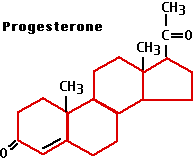Progesterone

Progesterone is one of the steroid hormones.
It is secreted by the corpus luteum and by the placenta and is responsible for preparing the body for pregnancy and, if pregnancy occurs, maintaining it until birth.
Corpus luteum
Progesterone secretion by the corpus luteum occurs after ovulation and
- continues the preparation of the endometrium for a possible pregnancy
- inhibits contraction of the uterus
- inhibits development of a new follicle
If pregnancy does not occur, secretion wanes toward the end of the menstrual cycle, and menstruation begins.
Placenta
If pregnancy does occur, the placenta begins to secrete progesterone which supplements that of the corpus luteum. In fact, by the fifth month of pregnancy, the placenta secretes sufficient progesterone by itself that the corpus luteum is no longer essential to maintain pregnancy.
A sharp decline in the level of progesterone is one of the triggers of birth.
Method of Action
Progesterone, like all steroids, is a small hydrophobic molecule. Thus it diffuses freely through the plasma membrane of all cells. However, in target cells, like those of the endometrium, it
- becomes tightly bound to a cytoplasmic protein the progesterone receptor.
- the complex of receptor and its hormone moves into the nucleus.
- there it binds to a progesterone response element
The progesterone response element is a specific sequence of DNA in the promoters of certain genes that is needed to turn those genes on (or off). Thus, the complex of progesterone with its receptor forms a transcription factor.
Progestins
Progestins are synthetic modifications of the progesterone molecule. Several different ones are widely prescribed for
- birth control pills ( and other forms of contraceptives)
- for hormone replacement therapy (HRT) to reduce the unpleasant symptoms of the menopause
- to treat young women who cease to menstruate normally
Some examples:
- norgestrel (Trade name = "Orvette"); used as an oral contraceptive
- levonorgestrel (used in the "Norplant" system: an implantable contraceptive)
- norethindrone (Trade name = "Aygestin"; used in HRT (hormone replacement therapy)
RU486 (also known as mifepristone) is a synthetic steroid related to progesterone.
Unlike the progestins discussed above, that mimic the action of progesterone, RU-486 blocks the action of progesterone.
(Synthetic molecules that mimic the action of a natural molecule are called agonists; those that oppose it are antagonists.)
RU-486 is a progesterone antagonist. It binds to the progesterone receptor, and in so doing prevents progesterone itself from occupying its receptor. Thus the gene transcription normally turned on by progesterone is blocked, and the proteins necessary to begin and maintain pregnancy are not synthesized.
If RU-486 is taken shortly after intercourse, it prevents pregnancy. If taken early in pregnancy, it causes the embryo to be aborted.
This result has caused RU-486 to be widely used in Europe to terminate early pregnancy. It has not found widespread acceptance in the U.S.
24 July 1999
